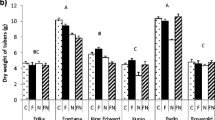Abstract
Effects of crop rotation on the incidence of soil-borne pathogens and on the performance of potato were investigated in five field experiments. Rotations differed in cropping frequency of potato and in crop sequence.
Incidence of stem canker caused byRhizoctonia solani was strongly influenced by the cropping frequency of potato and not by crops with which the potato was alternated in the rotation. Cropping frequency of potato also affected the occurrence of black scurf, but less pronounced than for stem canker. The antagonistVerticillium bigutatum slightly reducedR. solani (black scurf) in plots on sandy soil continuously cropped with potato. Incidence of stem canker was also strongly affected by granular nematicides applied to the soil, nitrogen level and the cultivar grown.
Stem infections byVerticillium dahliae depended on the cropping frequency of potato, by the crop with which the potato was alternated in the rotation and by the density and virulence of endoparasitic nematodes, especiallyMeloidogyne spp.
Crop rotation had no effect at all on incidence of common scab on tubers, whereas the effect of cropping frequency of potato on netted scab was highly significant. When cultivars were grown susceptible to both scab types, netted scab supressed common scab.
Similar content being viewed by others
References
Carling, D.E., Kebler, K.M. & Leiner, R.H., 1986. Interactions betweenRhizoctonia solani AG-3 and 27 plant species. Plant Disease 70: 577–578.
Carling, D.E. & Leiner, R.H., 1986. Isolation and characterization ofRhizoctonia solani and binucleateR. solani-like fungi from aerial stems and subterranean organs of potato plants. Phytopathology 76: 725–729.
Corbett, D.C.M., 1983. Three new species ofPratylenchus with a redescription ofP. andinus Lordello, Zamith & Boock, 1961 (Nematoda:Pratylenchidae). Nematologica 29: 390–403.
Corbett, D.C.M. & Hide, G.A., 1971. Interactions betweenHeterodera rostochiensis Woll. andVerticillium dahliae Kleb. on potatoes and the effect of CCC on both. Annals of Applied Biology 68: 71–80.
Evans, K., 1987. The interaction of potato cyst nematodes andVerticillium dahliae on early and main crop potato cultivars. Annals of Applied Biology 110: 329–339.
Faulkner, L.R. & Bolander, W.J., 1969. Interaction ofVerticillium dahliae andPratylenchus minyus in Verticillium wilt of peppermint: effect of soil temperature. Phytopathology 59: 868–870.
Hide, G.A. & Firmager, Janet P., 1990. Effects of an isolate ofRhizoctonia solani Kühn AG8 from diseased barley on the growth and infection of potatoes (Solanum tuberosum L.). Potato Research 33: 229–234.
Hofman, T.W., 1988. Effects of granular nematicides on the infection of potatoes byRhizoctonia solani. Thesis Wageningen Agricultural University: 1–123.
Jacobsen, B.J., McDonald, D.H. & Bissonette, H.L., 1979. Interactions betweenMeloidogyne hapla andVerticillium albo-atrum in the Verticillium wilt disease of potato. Phytopathology 69: 288–292.
Rowe, R.C., Riedel, R.M. & Martin, M.J., 1985. Synergistic interactions betweenVerticillium dahliae andPratylenchus penetrans in potato early dying disease. Phytopathology 75: 412–418.
Scholte, K., 1989a. The effect of netted scab (Streptomyces spp.) andVerticillium dahliae on growth and yield of potato. Potato Research 32: 65–73.
Scholte, K., 1989b. Effects of soil-borneRhizoctonia solani Kühn on yield and quality of ten potato cultivars. Potato Research 32: 367–376.
Scholte, K., 1989c. Effects of crop rotation and granular nematicides on the incidence ofVerticillium dahliae Kleb. andColletotrichum coccodes (Wallr.) Hughes, in potato. Potato Research 32: 377–385.
Scholte, K., 1990. Causes of differences in growth pattern, yield and quality of potatoes (Solanum tuberosum L.) in short rotations on sandy soil as affected by crop rotation, cultivar and application of granular nematicides. Potato Research 33: 181–190.
Scholte, K. & s'Jacob, J.J., 1990. Effect of crop rotation, cultivar and nematicide on growth and yield of potato (Solanum tuberosum L.) in short rotations on a marine clay soil. Potato Research 33: 191–200.
Scholte, K. & Labruyère, R.E., 1985. Netted scab: a new name for an old disease in Europe. Potato Research 28: 443–448.
Siti, E., Krikun, J., Orion, D. & Cohn, E., 1979.Verticillium-Pratylenchus interactions in potato. Phytoparasitica 7: 42.
Author information
Authors and Affiliations
Rights and permissions
About this article
Cite this article
Scholte, K. Effect of crop rotation on the incidence of soil-borne fungal diseases of potato. Netherlands Journal of Plant Pathology 98 (Suppl 2), 93–101 (1992). https://doi.org/10.1007/BF01974476
Accepted:
Issue Date:
DOI: https://doi.org/10.1007/BF01974476




